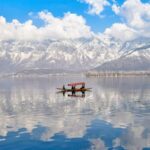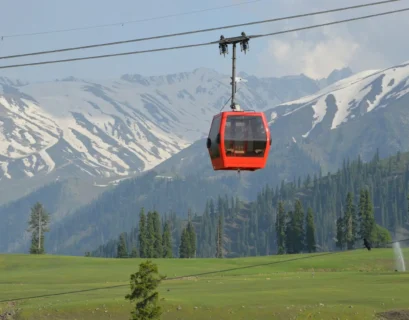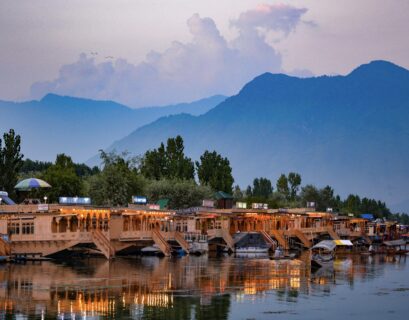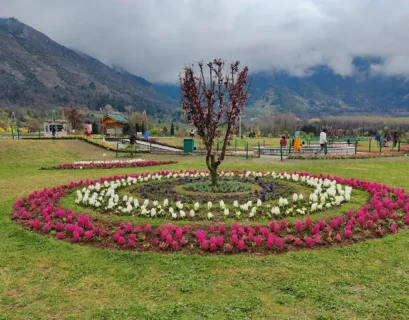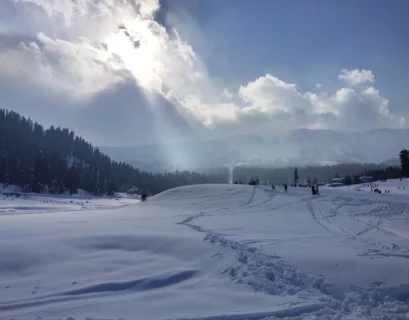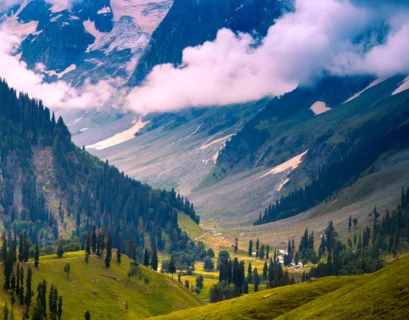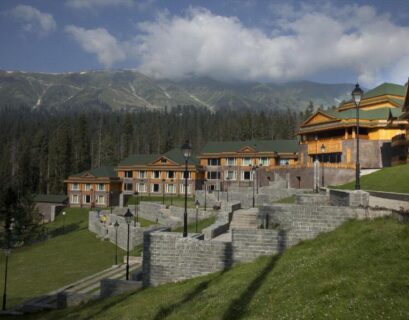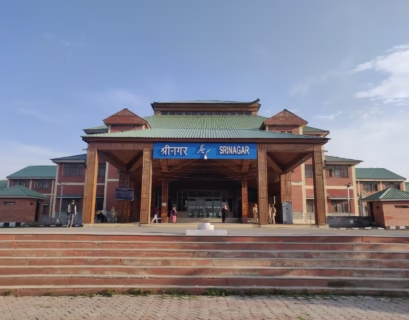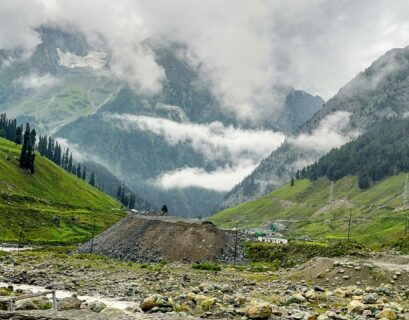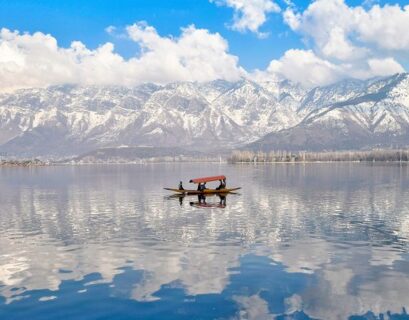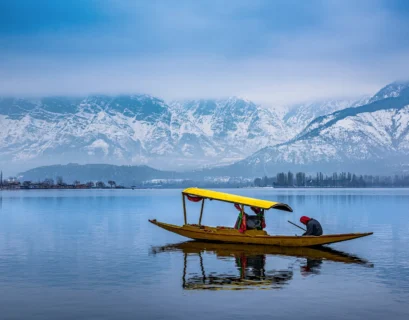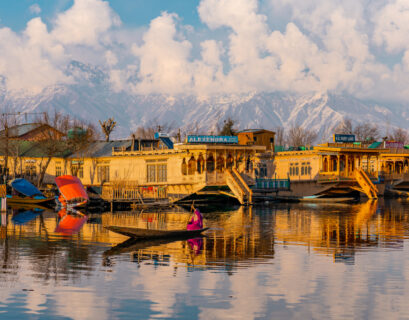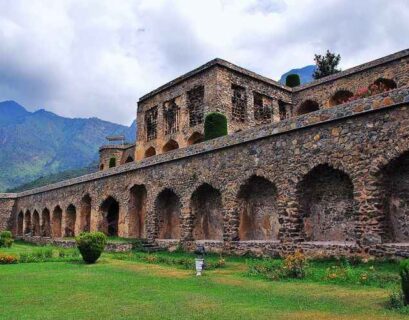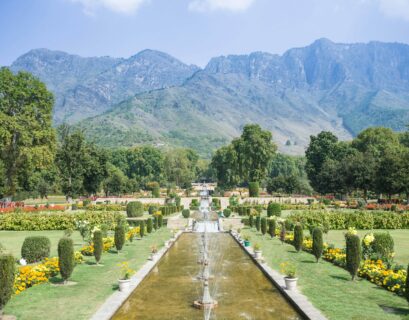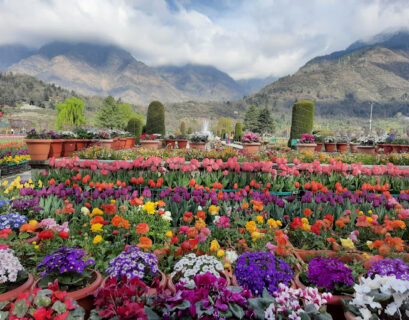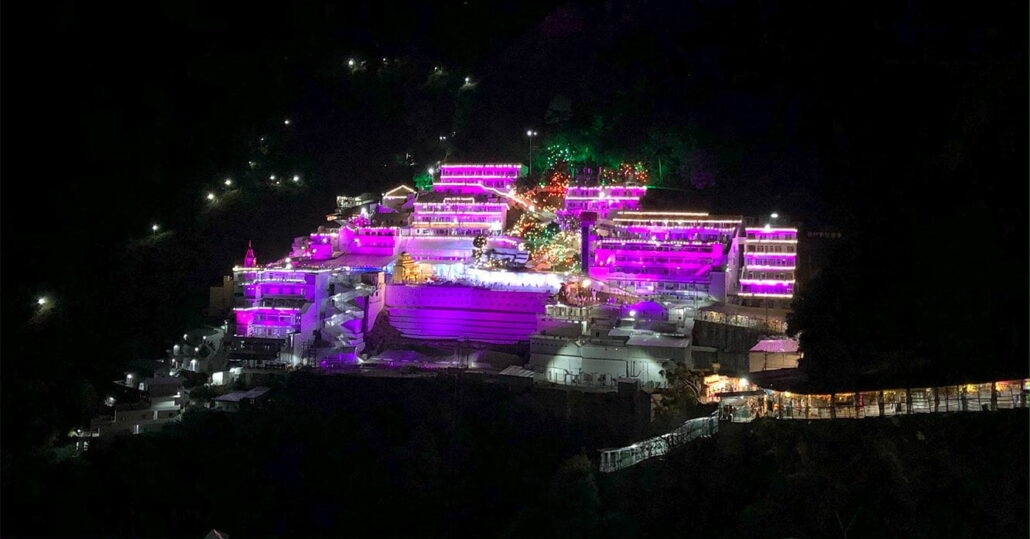Table of Contents
ToggleWeather in Srinagar Photos
Everything About Weather in Srinagar
Srinagar, the summer capital of Jammu and Kashmir, is celebrated for its stunning natural beauty, serene Dal Lake, and lush gardens. One of its most intriguing aspects is its unique and varied climate. In this detailed guide, we will explore the weather in Srinagar—from its geographical influences and seasonal variations to travel tips and future climate trends. Whether you’re a local planning your day or a traveler gearing up for a journey, understanding the intricacies of Srinagar’s weather can help you make the most of your visit.
Let’s dive in and explore the captivating climate of this iconic city.
Srinagar’s Geographical Canvas and Its Influence on Weather
Srinagar is nestled in the heart of the Kashmir Valley, surrounded by the majestic Himalayas. This unique geographical positioning plays a significant role in shaping the local weather. The mountains act as natural barriers that moderate temperatures, leading to a climate that is generally milder compared to other regions in northern India. The presence of water bodies like Dal Lake and the Jhelum River further influences local humidity and temperature variations throughout the year.
The high-altitude location and the valley’s bowl-like structure create distinct microclimates. This means that while the overall region experiences seasonal shifts, local weather conditions in Srinagar can vary from one area to another. Whether you are checking the weather in Srinagar for a quick update or planning an extended trip to explore the serene surroundings, understanding these geographical nuances is essential.
Seasonal Breakdown: What to Expect Throughout the Year
Srinagar experiences four distinct seasons, each with its own charm and challenges. The seasonal diversity is one of the reasons why the weather in Srinagar Kashmir is a major talking point among travelers and locals alike.
Spring: A Blooming Spectacle
Timeframe: March to May
Spring in Srinagar is nothing short of magical. As the winter chill recedes, the city transforms into a burst of colors with blooming tulips, rose gardens, and other floral marvels. The weather during this season is pleasantly cool, making it an ideal time for outdoor activities and sightseeing.
- Temperature Range: Generally between 8°C and 20°C.
- Key Highlights: Gardens like Shalimar Bagh and Nishat Bagh are in full bloom, providing a perfect backdrop for leisurely walks and photography.
This season is particularly appealing for nature enthusiasts and photographers who want to capture the vibrant transformation of the valley. With clear skies and gentle breezes, the weather in Srinagar during spring sets the stage for a memorable experience.
Summer: Cool Comfort Amidst the Heat
Timeframe: June to August
Unlike the scorching heat prevalent in many parts of India, Srinagar offers a refreshing respite during the summer months. The altitude and surrounding mountains keep temperatures moderate, allowing visitors to enjoy long, sunlit days without the extreme discomfort of high temperatures.
- Temperature Range: Typically between 15°C and 30°C.
- Key Highlights: Summer is the peak tourist season, as the pleasant weather is perfect for shikara rides on Dal Lake, exploring local markets, and visiting historic sites.
The cool and comfortable summer weather in Srinagar makes it a popular destination for those looking to escape the heat. The city’s outdoor attractions and cultural festivals add to the charm, making every day a new adventure.
Autumn: A Tapestry of Colors
Timeframe: September to November
Autumn in Srinagar is a season of transition and tranquility. As the lush greenery of summer gives way to warm, earthy tones, the weather becomes crisp and refreshing. The autumn months are characterized by clear skies, moderate temperatures, and a noticeable drop in humidity.
- Temperature Range: Usually between 10°C and 22°C.
- Key Highlights: The changing colors of the chinar trees, along with the crisp air, make this season perfect for nature walks and heritage tours. Many visitors also appreciate the calm before the onset of winter.
Autumn is an excellent time for those who enjoy a quieter, more reflective experience of Srinagar. The blend of mild weather and breathtaking natural beauty makes it a must-visit season for photographers and travel enthusiasts.
Winter: A Wonderland of Snow and Serenity
Timeframe: December to February
Winter transforms Srinagar into a picturesque winter wonderland. The cold months bring snowfall that blankets the city, creating a serene and almost surreal atmosphere. While the temperatures can drop significantly, the crisp, clear air offers a unique charm that attracts both winter sports enthusiasts and those looking to experience a true Himalayan winter.
- Temperature Range: Can dip below 0°C at times, with daytime averages ranging between -2°C and 8°C.
- Key Highlights: Snowfall adds a magical touch to the historic architecture and natural landscapes. Tourists often enjoy winter activities such as skiing in nearby areas and savoring local hot beverages.
Winter in Srinagar is not only a visual treat but also a period of cultural richness, as the harsh weather contrasts with the warmth of local hospitality. Visitors are encouraged to bundle up and immerse themselves in the tranquil beauty of a snow-covered Srinagar.
Key Factors Influencing Srinagar’s Weather
Several elements come into play when determining the weather in Srinagar. Here are some of the most critical factors:
Himalayan Influence
The towering Himalayas play a pivotal role in shaping the climate. These mountains not only regulate temperature but also influence weather patterns such as precipitation. Their presence ensures that Srinagar experiences relatively moderate temperatures in summer and dramatic snowfall in winter.
Altitude and Topography
At an elevation of about 1,585 meters (5,200 feet) above sea level, Srinagar’s altitude contributes to its cooler climate. The valley’s topography, surrounded by high mountains, creates a unique microclimate that results in distinct weather patterns compared to the surrounding plains.
Water Bodies
Dal Lake and the Jhelum River have a moderating effect on the local climate. These water bodies help maintain humidity levels and can even slightly influence local temperatures, particularly during the transition periods between seasons.
Monsoonal Impact
Although Srinagar does not experience the heavy monsoon rains seen in other parts of India, the seasonal monsoon does bring occasional showers. These light rains are essential for replenishing the natural flora and contribute to the overall ecosystem of the region.
Climate Change Considerations
In recent years, like many parts of the world, Srinagar has seen subtle shifts in its weather patterns. While the seasonal rhythms remain largely unchanged, there are indications of increased variability in temperatures and precipitation. This evolving scenario is an important area of study for meteorologists and environmentalists alike.
Understanding these factors is crucial for anyone interested in accurate weather predictions and planning a visit. By keeping these influences in mind, locals and tourists can better prepare for the day-to-day changes in the weather in Srinagar Kashmir.
In-Depth Analysis: Weather in Srinagar Kashmir
The terms weather in Srinagar and weather in Srinagar Kashmir encapsulate a rich tapestry of climatic diversity influenced by nature’s grandeur. Here’s a closer look at what these phrases represent:
Unique Microclimates
Due to its location in the heart of the Kashmir Valley, Srinagar experiences several microclimates within a relatively small area. From the snow-capped peaks that border the city to the warmer, more humid pockets near Dal Lake, the variability is both fascinating and significant for local agriculture, tourism, and daily life.
Weather Forecasting and Modern Tools
Advancements in meteorology have enabled more precise forecasting for Srinagar. High-resolution weather models now provide detailed updates, helping residents and tourists alike plan their activities. Whether you’re looking for real-time updates or planning a long-term trip, modern technology offers comprehensive insights into the region’s climate dynamics.
Impact on Local Lifestyle and Economy
The climate in Srinagar directly affects the lifestyle of its residents. Agriculture, particularly the cultivation of fruits like apples and walnuts, is closely tied to the seasonal weather patterns. Additionally, tourism—a major economic driver—thrives during the milder months when the weather in Srinagar Kashmir is most inviting.
By understanding these aspects, one can appreciate the delicate balance that nature maintains in this region. The interplay between natural elements and human activity creates a unique environment where every season brings its own set of opportunities and challenges.
Best Time to Visit Srinagar: A Seasonal Guide for Tourists
Choosing the right time to visit Srinagar is essential for an enjoyable trip. Here’s a seasonal guide to help you decide based on the weather in Srinagar:
Spring Visits
- Ideal for: Nature walks, photography, and exploring the famed Mughal gardens.
- Highlights: Blooming flowers, moderate temperatures, and clear skies.
- Travel Tip: Carry light jackets and comfortable footwear for walking through garden paths and historic sites.
Summer Escapes
- Ideal for: Shikara rides on Dal Lake, outdoor adventures, and local festivals.
- Highlights: Pleasant temperatures and long daylight hours.
- Travel Tip: Though the weather is cool during the day, evenings might be a bit breezy. Always have a light sweater handy.
Autumn Adventures
- Ideal for: Cultural tours, heritage walks, and experiencing the local art scene.
- Highlights: A visual feast of autumnal hues, clear air, and fewer tourists.
- Travel Tip: Early autumn is perfect for outdoor photography. Pack layers to adjust to the mild daytime warmth and cooler evenings.
Winter Retreats
- Ideal for: Experiencing the magic of snowfall, winter sports, and cozy evenings by the fire.
- Highlights: Scenic snowy landscapes and a unique perspective on historic architecture.
- Travel Tip: Prepare with warm clothing, waterproof footwear, and accessories like gloves and scarves. Winter travel in Srinagar requires a bit more planning, but the experience is truly unforgettable.
By aligning your travel plans with the local seasonal offerings, you can optimize your experience and make the most out of the weather in Srinagar Kashmir. Each season has its own charm, making Srinagar a year-round destination with something unique to offer every visitor.
Local Festivals and the Cultural Impact of Srinagar’s Climate
The vibrant cultural scene in Srinagar is deeply intertwined with its climate. Many local festivals and traditions are celebrated in harmony with the seasonal changes, providing insights into the city’s historical and cultural fabric.
Spring Festivals
- Tulip Festival: Celebrated with great enthusiasm, the Tulip Festival highlights the blooming gardens and the city’s affinity for nature.
- Cultural Fairs: Numerous local fairs coincide with the mild weather, allowing artisans and performers to showcase traditional Kashmiri crafts and music.
Summer Celebrations
- Shikara Rides and Lake Festivals: The pleasant summer weather makes Dal Lake a hub for water-based activities. Local festivals celebrate the lake’s beauty with boat races and cultural performances.
- Local Markets and Handicraft Exhibitions: The bustling bazaars come alive in the summer, offering a glimpse into the rich heritage and crafts of Kashmir.
Autumn Traditions
- Harvest Celebrations: Autumn is a time for gratitude and reflection. Local harvest festivals pay homage to the bounty of the land, reflecting the balanced and clear conditions of the season.
- Art and Music Festivals: Cooler weather and longer evenings encourage community gatherings centered around music, poetry, and traditional art forms.
Winter Festivities
- Winter Markets: Despite the chill, winter markets offer a cozy and intimate glimpse into Kashmiri life. Traditional foods, warm beverages, and handcrafted goods are on full display.
- Cultural Evenings: With early sunsets and crisp nights, local families and communities often gather indoors for storytelling, traditional music, and festive celebrations.
These cultural events not only celebrate the seasons but also provide a deeper connection to the local heritage. The way in which the climate influences these traditions makes understanding the weather in Srinagar even more meaningful for both visitors and residents.
Practical Tips for Tourists: Navigating Srinagar’s Weather
Whether you’re planning a short visit or an extended stay, being well-prepared for Srinagar’s diverse weather conditions is crucial. Here are some practical tips to ensure you have a comfortable and enjoyable trip:
What to Pack
- Layered Clothing: Given the significant temperature variations between seasons, layering is key. Carry light clothes for the day and warmer layers for the evening, especially during autumn and winter.
- Rain Gear: Although heavy rains are uncommon, an umbrella or a light raincoat can be handy during occasional showers.
- Footwear: Comfortable walking shoes are a must, particularly if you plan to explore the city’s gardens, markets, and heritage sites on foot.
- Accessories: Sunglasses, hats, and sunscreen are essential for sunny days, especially during summer, while gloves, scarves, and thermal wear are necessary for the winter months.
Local Transportation and Travel Tips
- Navigating the City: The city’s layout, with its winding roads and bustling markets, calls for a flexible travel plan. Local transport options like shikara rides, taxis, and traditional buses are influenced by seasonal weather.
- Stay Updated: Use reliable weather apps and local forecasts to stay informed about daily changes in the weather in Srinagar Kashmir. This is particularly useful when planning outdoor activities.
- Cultural Etiquette: Respect local customs, especially during festivals and community events that are closely tied to the local climate and seasonal activities.
Health and Safety Considerations
- Hydration: Regardless of the season, staying hydrated is important. Carry bottled water with you, especially when exploring outdoor sites.
- Altitude Awareness: Srinagar’s altitude can sometimes affect visitors unaccustomed to higher elevations. Take it easy during the first few days to allow your body to acclimatize, particularly if you plan to engage in physically demanding activities.
- Local Advice: Don’t hesitate to ask locals or your hotel staff for advice on weather conditions, especially if sudden changes occur.
These practical tips not only help you navigate the weather in Srinagar but also enrich your overall travel experience by ensuring you’re well-prepared for every eventuality.
The Future of Srinagar’s Weather: Climate Change and Adaptation
Like many parts of the world, Srinagar is not immune to the impacts of climate change. Scientists have observed subtle yet significant shifts in weather patterns over the past decades, which have implications for the local environment and community.
Notable Changes and Trends
- Temperature Variability: While the traditional seasonal cycles remain, there is evidence of increased temperature fluctuations. Even during the mild seasons, unexpected cold snaps or warm spells can occur.
- Precipitation Patterns: Changes in rainfall distribution have been noted, with some areas experiencing more intense, albeit shorter, periods of precipitation. This variability can affect agriculture and water management systems.
- Snowfall Patterns: Winters in Srinagar may see variations in snowfall patterns. While snow remains a defining characteristic of the season, the frequency and intensity of snowfall events could be impacted by broader climatic shifts.
Adaptation and Mitigation Efforts
Local authorities and environmental organizations are actively working to mitigate the effects of climate change. Initiatives include:
- Enhancing weather forecasting systems to provide more accurate and timely information.
- Promoting sustainable tourism practices that are mindful of the environmental footprint.
- Investing in infrastructure improvements to cope with potential extremes in weather, ensuring that both residents and tourists remain safe and comfortable.
By staying informed about these changes and understanding how they might affect daily life, visitors can better appreciate the delicate balance that defines the weather in Srinagar Kashmir. These insights also underscore the importance of supporting sustainable practices to preserve the natural beauty of the region for future generations.
Embracing the Unique Charm of Srinagar’s Climate
The weather in Srinagar is more than just a meteorological phenomenon—it is a vital part of the city’s identity. From the blossoming gardens of spring to the snow-blanketed landscapes of winter, each season tells a story of nature’s artistry and resilience.
The Role of Weather in Shaping Local Life
- Agriculture: The seasonal rhythms dictate planting and harvesting cycles, influencing local cuisine and traditions. The fertile soil and predictable weather patterns have supported local farming for centuries.
- Tourism: The diverse weather conditions make Srinagar a year-round destination. Whether it’s the cool comfort of summer or the dramatic allure of winter, every season offers a unique experience for visitors.
- Cultural Heritage: Local festivals and cultural events are intricately linked to the weather. These traditions reflect the community’s deep connection with nature and their adaptive lifestyle in response to seasonal changes.
A Destination That Evolves with Every Season
For travelers, experiencing the weather in Srinagar is akin to witnessing nature’s ever-changing canvas. Every visit brings something new—a burst of spring colors, the gentle warmth of summer days, the reflective beauty of autumn, or the serene silence of a snowy winter. This variability not only enhances the travel experience but also encourages a deeper connection with the local environment.
Final Thoughts: Why Understanding Srinagar’s Weather Enhances Your Visit
The weather in Srinagar is a complex interplay of natural forces, geographical features, and cultural influences. Whether you’re checking the weather in Srinagar Kashmir for your daily commute or planning an elaborate holiday itinerary, being aware of the seasonal patterns and local climatic factors can greatly enhance your experience.
As you plan your next visit or enjoy a day in this beautiful city, remember that Srinagar’s ever-changing climate offers endless opportunities for exploration, reflection, and appreciation of nature’s diversity. Each season unfolds a new chapter, inviting you to experience the beauty and challenges of life in this enchanting part of Kashmir.
Thank you for joining this in-depth exploration of Srinagar’s weather. Whether you are a local or a visitor, we hope this guide enriches your understanding of the climate and inspires you to embrace every season with open arms.
With the right information and preparation, every visit to Srinagar can be a memorable adventure. Happy travels, and may every season in Srinagar bring you new wonders to discover!
Weather in Srinagar People Also Ask
What is the average temperature in Srinagar throughout the year?
Srinagar experiences cold winters with temperatures dropping below freezing and pleasant summers with highs around 30°C.
What is the best time to visit Srinagar for good weather?
The best time to visit Srinagar is from April to October when the weather is pleasant, and the flowers and greenery are at their peak.
Does Srinagar experience snowfall?
Yes, Srinagar receives snowfall during winter, typically from December to February, making it a popular winter destination.
How cold does Srinagar get in winter?
Temperatures in Srinagar during winter can drop as low as -6°C or even lower, especially in January.
What is the temperature in Srinagar during summer?
In summer, temperatures in Srinagar range between 15°C and 30°C, offering a cool retreat compared to other parts of India.
Is Srinagar too hot in May and June?
Srinagar remains pleasant in May and June, with temperatures between 20°C and 30°C, much cooler than most of North India.
What is the monsoon season like in Srinagar?
Srinagar experiences mild monsoon rains from July to September, with moderate rainfall and cool temperatures.
Does it rain heavily in Srinagar?
Srinagar does not receive heavy monsoon rains like other parts of India. The rainfall is moderate and does not disrupt travel much.
What is the coldest month in Srinagar?
January is usually the coldest month in Srinagar, with temperatures often dropping below freezing.
What is the hottest month in Srinagar?
July is typically the warmest month in Srinagar, with daytime temperatures reaching around 30°C.
What is the temperature of Dal Lake in winter?
During winter, Dal Lake partially freezes when temperatures drop below zero, creating a stunning frozen landscape.
How does the temperature in Srinagar compare to Gulmarg?
Gulmarg is colder than Srinagar, especially in winter, with heavy snowfall and lower temperatures.
Is it safe to visit Srinagar in winter?
Yes, Srinagar is safe to visit in winter, but be prepared for cold weather and possible travel delays due to snowfall.
What should I pack for a trip to Srinagar in winter?
Pack heavy woolens, thermals, gloves, and waterproof shoes to stay warm and comfortable.
What should I pack for a summer trip to Srinagar?
Light woolens or jackets are advisable, as evenings can be cool despite warm daytime temperatures.
Does Srinagar have a dry or humid climate?
Srinagar has a moderately humid climate, but it is not as humid as coastal regions of India.
What are the temperature variations between day and night in Srinagar?
Daytime temperatures can be warm, but nights are often significantly cooler, even in summer.
Does Srinagar experience foggy weather?
Srinagar occasionally experiences fog, mostly in winter, reducing visibility in the early mornings.
Can I visit Srinagar during the monsoon season?
Yes, you can visit during monsoon as rainfall is not very heavy, and the landscape is lush and green.
How does altitude affect the temperature in Srinagar?
Srinagar’s altitude (1,585 meters) keeps temperatures cooler than the plains, making it a year-round tourist destination.
What is the temperature of Srinagar during spring?
Spring (March-April) in Srinagar sees temperatures between 10°C and 20°C, with blooming flowers and pleasant weather.
How long does winter last in Srinagar?
Winter in Srinagar usually lasts from November to February, with chilly temperatures and occasional snowfall.
What is the best season to see snow in Srinagar?
December to February is the best time to experience snowfall in Srinagar.
Does Srinagar have extreme weather conditions?
Srinagar experiences cold winters but does not face extreme weather conditions like deserts or coastal areas.
How does Srinagar’s weather compare to Leh or Manali?
Srinagar is milder than Leh, which is colder due to its higher altitude, and less snowy than Manali in peak winters.


